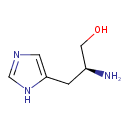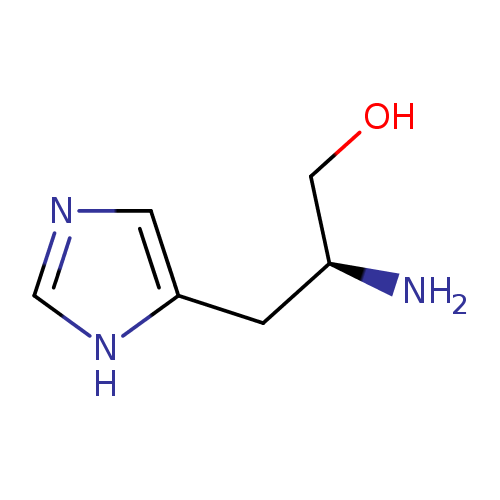|
Record Information |
|---|
| Version |
1.0 |
|---|
| Update Date |
1/22/2018 11:54:54 AM |
|---|
|
Metabolite ID | PAMDB110046 |
|---|
|
Identification |
|---|
| Name: |
histidinol |
|---|
| Description: | An amino alcohol that is propanol substituted by 1H-imidazol-4-yl group at position 3 and an amino group at position 2 (the 2S stereoisomer). |
|---|
|
Structure |
|
|---|
| Synonyms: | |
|---|
|
Chemical Formula: |
C6H12N3O
|
|---|
| Average Molecular Weight: |
142.18 |
|---|
| Monoisotopic Molecular
Weight: |
142.0980370229 |
|---|
| InChI Key: |
ZQISRDCJNBUVMM-YFKPBYRVSA-O |
|---|
| InChI: |
InChI=1S/C6H11N3O/c7-5(3-10)1-6-2-8-4-9-6/h2,4-5,10H,1,3,7H2,(H,8,9)/p+1/t5-/m0/s1 |
|---|
| CAS
number: |
4836-52-6 |
|---|
| IUPAC Name: | (2S)-2-amino-3-(1H-imidazol-4-yl)propan-1-ol |
|---|
|
Traditional IUPAC Name: |
HSO |
|---|
| SMILES: | C1(NC=NC=1CC(CO)[N+]) |
|---|
|
Chemical Taxonomy |
|---|
|
Taxonomy Description | This compound belongs to the class of chemical entities known as aralkylamines. These are alkylamines in which the alkyl group is substituted at one carbon atom by an aromatic hydrocarbyl group. |
|---|
|
Kingdom |
Chemical entities |
|---|
| Super Class | Organic compounds |
|---|
|
Class |
Organic nitrogen compounds |
|---|
| Sub Class | Organonitrogen compounds |
|---|
|
Direct Parent |
Aralkylamines |
|---|
| Alternative Parents |
|
|---|
| Substituents |
- Aralkylamine
- Azole
- Imidazole
- Heteroaromatic compound
- 1,2-aminoalcohol
- Azacycle
- Organoheterocyclic compound
- Organic oxygen compound
- Primary amine
- Primary alcohol
- Organooxygen compound
- Primary aliphatic amine
- Alcohol
- Hydrocarbon derivative
- Organopnictogen compound
- Aromatic heteromonocyclic compound
|
|---|
| Molecular Framework |
Aromatic heteromonocyclic compounds |
|---|
| External Descriptors |
|
|---|
|
Physical Properties |
|---|
| State: |
Solid |
|---|
| Charge: | 0 |
|---|
|
Melting point: |
Not Available |
|---|
| Experimental Properties: |
| Property | Value | Reference |
|---|
| Melting Point | Not Available | Not Available | | Boiling Point | Not Available | Not Available | | Water Solubility | Not Available | Not Available | | LogP | Not Available | Not Available |
|
|---|
| Predicted Properties |
|
|---|
|
Biological Properties |
|---|
| Cellular Locations: |
Not Available |
|---|
| Reactions: | |
|---|
|
Pathways: |
Not Available |
|---|
|
Spectra |
|---|
| Spectra: |
| Spectrum Type | Description | Splash Key | |
|---|
| GC-MS | GC-MS Spectrum - GC-EI-TOF (Pegasus III TOF-MS system, Leco; GC 6890, Agilent Technologies) (3 TMS) | splash10-0udi-1970000000-5f8fce52ae008e9577d3 | View in MoNA |
|---|
| GC-MS | GC-MS Spectrum - GC-EI-TOF (Pegasus III TOF-MS system, Leco; GC 6890, Agilent Technologies) (3 TMS) | splash10-0udi-1960000000-2bd5915e1e2204265b30 | View in MoNA |
|---|
| GC-MS | GC-MS Spectrum - GC-EI-TOF (Pegasus III TOF-MS system, Leco; GC 6890, Agilent Technologies) | splash10-0udi-0960000000-04ea4478dfe81318bf5c | View in MoNA |
|---|
| GC-MS | GC-MS Spectrum - GC-EI-TOF (Pegasus III TOF-MS system, Leco; GC 6890, Agilent Technologies) (3 TMS) | splash10-0fk9-9540000000-9d5008be3cb2086af6f4 | View in MoNA |
|---|
| Predicted GC-MS | Predicted GC-MS Spectrum - GC-MS | Not Available |
|---|
| LC-MS/MS | LC-MS/MS Spectrum - Quattro_QQQ 10V, Positive (Annotated) | splash10-006x-1900000000-c360dc1772243d0c7cca | View in MoNA |
|---|
| LC-MS/MS | LC-MS/MS Spectrum - Quattro_QQQ 25V, Positive (Annotated) | splash10-001i-9000000000-eba5a77ea4a62d8375f8 | View in MoNA |
|---|
| LC-MS/MS | LC-MS/MS Spectrum - Quattro_QQQ 40V, Positive (Annotated) | splash10-001i-9000000000-009922321d7904037f80 | View in MoNA |
|---|
| LC-MS/MS | LC-MS/MS Spectrum - LC-ESI-QQ (API3000, Applied Biosystems) 10V, Positive | splash10-0006-0900000000-3a563827d1023d4dadd7 | View in MoNA |
|---|
| LC-MS/MS | LC-MS/MS Spectrum - LC-ESI-QQ (API3000, Applied Biosystems) 20V, Positive | splash10-00e9-7900000000-4baa9781af4596ef1a49 | View in MoNA |
|---|
| LC-MS/MS | LC-MS/MS Spectrum - LC-ESI-QQ (API3000, Applied Biosystems) 30V, Positive | splash10-001i-9000000000-98f4a65357b52f544e0c | View in MoNA |
|---|
| LC-MS/MS | LC-MS/MS Spectrum - LC-ESI-QQ (API3000, Applied Biosystems) 40V, Positive | splash10-001i-9000000000-5921f5ed9c6159fbe48e | View in MoNA |
|---|
| LC-MS/MS | LC-MS/MS Spectrum - LC-ESI-QQ (API3000, Applied Biosystems) 50V, Positive | splash10-001i-9000000000-a7a82388a3feef766362 | View in MoNA |
|---|
| LC-MS/MS | LC-MS/MS Spectrum - LC-ESI-QTOF (UPLC Q-Tof Premier, Waters) , Positive | splash10-0089-8900000000-b7fa72e4e20dbc5d79d2 | View in MoNA |
|---|
| Predicted LC-MS/MS | Predicted LC-MS/MS Spectrum - 10V, Positive | Not Available |
|---|
| Predicted LC-MS/MS | Predicted LC-MS/MS Spectrum - 20V, Positive | Not Available |
|---|
| Predicted LC-MS/MS | Predicted LC-MS/MS Spectrum - 40V, Positive | Not Available |
|---|
| Predicted LC-MS/MS | Predicted LC-MS/MS Spectrum - 10V, Negative | Not Available |
|---|
| Predicted LC-MS/MS | Predicted LC-MS/MS Spectrum - 20V, Negative | Not Available |
|---|
| Predicted LC-MS/MS | Predicted LC-MS/MS Spectrum - 40V, Negative | Not Available |
|---|
| 1D NMR | 1H NMR Spectrum | Not Available |
|---|
| 1D NMR | 1H NMR Spectrum | Not Available |
|---|
| 1D NMR | 13C NMR Spectrum | Not Available |
|---|
| 2D NMR | [1H,13C] 2D NMR Spectrum | Not Available |
|---|
|
|---|
|
References |
|---|
| References: |
- Warrington RC, Cheng I, Fang W (1991)Effects of L-histidinol on the proliferation and anticancer drug susceptibility of cultured B16f10 melanoma cells. Anticancer research 11, Pubmed: 1768057
- Gaber RF, Kielland-Brandt MC, Fink GR (1990)HOL1 mutations confer novel ion transport in Saccharomyces cerevisiae. Molecular and cellular biology 10, Pubmed: 2405251
- Zaharko D, Plowman J, Waud W, Dykes D, Malspeis L (1992)L-histidinol: preclinical therapeutic studies in combination with antitumor agents and pharmacokinetic studies in mice. Cancer research 52, Pubmed: 1617631
- Andorn N, Aronovitch J (1982)Purification and properties of histidinol dehydrogenase from Escherichia coli B. Journal of general microbiology 128, Pubmed: 7042909
- Kohnoe S, Maehara Y, Takahashi I, Yoshida M, Emi Y, Baba H, Sugimachi K (1993)L-histidinol potentiates hyperthermic cell-killing in-vitro. International journal of oncology 3, Pubmed: 21573440
- Stolfi RL, Martin DS (1990)Chemotherapeutic activity of L-histidinol against spontaneous, autochthonous murine breast tumors. Chemotherapy 36, Pubmed: 2292205
- Raju RV, Datla RS, Warrington RC, Sharma RK (1998)Effects of L-histidine and its structural analogues on human N-myristoyltransferase activity and importance of EEVEH amino acid sequence for enzyme activity. Biochemistry 37, Pubmed: 9778369
- Warrington RC, Fang WD, Zhang L, Shieh M, Saier MH (1996)Mimetics of L-histidinol which selectively modulate daunomycin toxicity in normal and tumorigenic epithelial cells. Anticancer research 16, Pubmed: 9042234
- Warrington RC, Cheng I, Zhang L, Fang WD (1993)L-histidinol increases the vulnerability of cultured human leukemia and lymphoma cells to anticancer drugs. Anticancer research 13, Pubmed: 8297120
- Warrington RC, Wratten N, Hechtman R (1977)L-Histidinol inhibits specifically and reversibly protein and ribosomal RNA synthesis in mouse L cells. The Journal of biological chemistry 252, Pubmed: 885850
|
|---|
| Synthesis Reference: |
Beltra, A. P.; Bonete, P.; Gonzalez-Garcia, J.; Garcia-Garcia, V.; Montiel, V. Electrochemical synthesis of L-histidinol using solvated electrons. Journal of the Electrochemical Society (2005), 152(4), D65-D68. |
|---|
| Material Safety Data Sheet (MSDS) |
Download (PDF) |
|---|
|
Links |
|---|
| External Links: |
|
|---|


